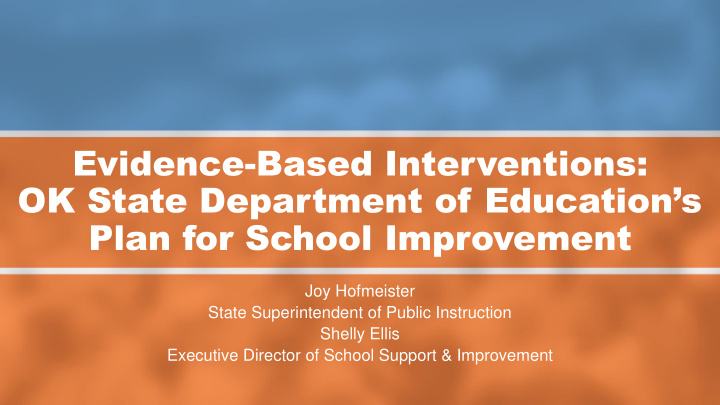



Evidence-Based Interventions: OK State Department of Education’s Plan for School Improvement Joy Hofmeister State Superintendent of Public Instruction Shelly Ellis Executive Director of School Support & Improvement
Role ole of of Sc School hool Suppor Support “Developing positive on -site relationships is a priority for the agency’s school support specialists, who guide schools toward solving their own problems…” Oklahoma Edge. Oklahoma’s Consolidated ESSA Plan. p. 82 http://sde.ok.gov/sde/sites/ok.gov.sde/files/documents/files/OK_consolidatedStateplan01122018.pdf
Elementar Elementary y & & Mid Middle dle Sc School hool Repor eport Car t Card Four Indicators: • Academic Achievement • Academic Growth • English Language Proficiency Assessment Progress • Chronic Absenteeism
High High Sc School hool Repor eport t Car Card Five Indicators: • Academic Achievement • Graduation Rate • Postsecondary Opportunities • English Language Proficiency Progress • Chronic Absenteeism
ESSA School Support Designations • Comprehensive School Improvement (CSI) • Additional Targeted Support Improvement (ATSI) • Targeted Support Improvement (TSI)
Comprehensive School Improvement (CSI) • Identified from among all schools in the state • Bottom 5% of school sites • Any high school with a graduation rate of 67% or below will also be identified as a Comprehensive School Improvement (CSI) Site • Designated every three (3) years • Comprehensive School Improvement (CSI) Cohort one (2018-2021)
Additional Targeted Support Improvement (ATSI) • Identified annually • Uses same methodology as Comprehensive School Improvement • Divided into student group performance: • Economically disadvantaged students; • Students with disabilities • English Learners (EL) • Major racial and ethnic groups • American Indian • Asian/Pacific Islander • Black/African American • Hispanic/Latino • White • Two or more races
Targeted School Improvement (TSI) • Targeted School Improvement (TSI) • Designated annually • When at least one student group is in the bottom 5% on two or more indicators in the accountability system • First year of designation is 2019-2020 • Three consecutive years of identification = Comprehensive School Improvement designation
Sc School hool Impr Improvement ement Pr Proces ocess Step 1: Identify Local Needs by completing a Comprehensive Needs Assessment •Oklahoma’s Nine Essential Elements • Parent Surveys • Student Surveys • Teacher Surveys • Site Administrator Surveys • Multiple Measures of Data including Oklahoma State Testing Program Data • Assignment of School Support Specialist to Site
9 Essential Elements Framework Academic Learning Leadership Performance Environment OEE Curriculum OEE School Culture OEE Leadership 1 4 7 OEE Classroom OEE Student, Family, OEE Organizational Evaluation/ and Community Structure and 2 5 8 Assessment Support Resources OEE Instruction OEE Professional OEE Comprehensive Growth, and Effective 3 6 9 Development, Planning and Evaluation
School Improvement Process Step 2: Select relevant, evidence-based interventions & practices. ESSA requires that designated sites use Evidence-Based Interventions (EBIs) for improvement Evidence-based refers to a strategy or intervention that demonstrates a statistically significant effect on improving student outcomes (ESEA section 8101(21)(A))
Evidence-Based Interventions Three levels of evidence: • Strong evidence - demonstrated by at least one well-designed and well- implemented experimental study; • Moderate evidence - demonstrated by at least one well-designed and well- implemented quasi-experimental study; • Promising evidence - demonstrated by at least one well-designed and well- implemented correlational study with statistical control for selection bias. *Fourth level: • Evidence building - demonstrates a rationale based on high-quality research findings or positive evaluation that an intervention is likely to improve student outcomes that do not yet have an evidence-base qualifying as one of the first three levels.
School Improvement Process Step 3: Plan for implementation • Spring 2019 • Regional Meetings • Training • On-Site Visits • Technical Assistance • Professional Learning • Develop SMART goals • Specific, Measurable, Achievable, Relevant, Time Bound • Develop Action Plan
School Improvement Process Step 4: Implementation of Plan • 2019-2020 • Assignment of School Support Specialist to Site • Instructional Coaching • Leadership Coaching • Model Teaching • Professional Learning
School Improvement Process Step 5: Examine & Reflect • Quarterly review of site benchmark data • Progress monitoring by OSDE staff • End of year data review • Revise plan as needed
Office of School Support & Improvement • Shelly Ellis, Ph.D., Executive • Megan McElroy-Griffith, M.Ed., Director School Support Specialist • Robin Anderson, M.Ed., Director • Kelly Otis, M.Ed., School of School Improvement Grants Support Specialist • Deborah Cornelison, M.Ed., • Joyce Rock, M.Ed., School School Support Specialist Support Specialist • Lorraine Eldrenkamp, M.Ed., • Shawna Wilson, M.Ed., School School Support Specialist Support Specialist • Jan Foreman, M.Ed., School • Zada Sery, B.S., Grants Support Specialist Management Specialist • Janie Stewart, School Support Coordinator
Recommend
More recommend